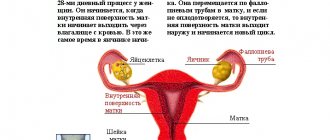Menstruation - This is one of the periods of the menstrual cycle, which is an important aspect in the life of any woman. Most often, menstruation begins at the age of 10-14 years; it depends on the individual characteristics of the woman’s body; genetic predisposition plays a significant role. Over the next 30-40 years, the woman is accompanied by this process. During this time, 70% of women experience various types of menstrual cycle disruptions. Such violations can occur at any age; neither girls nor women are immune from this. Even with external similarities, the causes of such disorders and their symptoms are different.
What is NMC
NMC is a menstrual cycle disorder that can occur in every woman. Both pathological reasons (inflammation, hormonal imbalances) and physiological ones (pregnancy or the body’s reaction to climate change) can contribute to this.
Menstruation is an integral part of a woman's life. The norm is a menstrual cycle, the duration of which is 21–35 days. It all depends on the physiological characteristics of the female body. Single deviations from the norm for up to five days are not considered pathological, but if there are systematic delays in menstruation for 5 days or more, you should consult a doctor, as this may be a sign of NMC, which without timely treatment can provoke serious complications.
An example of justification by the NMC for a contract for the wholesale supply of petroleum products using market analysis
| № | Provider | Price (RUB per ton) | Number of tons | Source of information |
| 1 | Supplier 1 | 45000,00 | 65,9 | Commercial offer dated 08/24/2016 |
| 2 | Supplier 2 | 45500,00 | 65,9 | Commercial offer dated 08/24/2016 |
| 3 | Supplier 3 | 46000,00 | 65,9 | Commercial offer dated 08/24/2016 |
The average price per ton of gasoline is 45,000 rubles, which means the NMC of the entire purchase is 2 million 998 thousand 450 rubles.
Types of pathology and their symptoms
Symptoms of abnormalities can manifest themselves in different ways, depending on what type they are. Currently, experts identify the following menstrual cycle disorders:
- Algodismenorrhea. Painful menstruation, which is accompanied by headache and general malaise. Intestinal disturbances, nausea, and mood swings may occur. In teenage girls during the formation of the cycle, this condition can be considered normal. This type of violation is the most common.
- Amenorrhea. Characterized by the absence of menstruation for six months or more. It can be primary - when menstruation does not begin until the age of 16. In this case, the NMC in the ICD is code 91.0. Secondary amenorrhea occurs in women of reproductive age who have an established cycle. NMC of the amenorrhea type is a pathological condition that requires immediate treatment.
- Oligomenorrhea. Characterized by short menstruation - no more than two days. In ICD 10, NMCs of this type are coded 91.3–91.5.
- Hypomenorrhea. Scanty menstruation, in which the volume of blood released is very small.
- Hypermenorrhea. Very heavy periods.
- Menorrhagia. These are menstruation that occur without delay, but are abundant and last a very long time (over 7 days). This condition is not an independent disease, but a sign of other serious disorders in a woman’s body.
- Polymenorrhea. This is what we call frequent periods. In this case, the woman experiences a short menstrual cycle.
Common signs of disorders include nagging pain in the lower abdomen and lumbar region, dizziness, weakness, vomiting and bowel movements. Also, in some cases, obesity and infertility are observed.
Anovulatory and postmenopausal metrorrhagia
Anovulatory metrorrhagia is a type of dysfunctional uterine bleeding. Pathology often manifests itself in adolescents and women who are at menopausal age.
Adult girls may experience an anovulatory cycle 1 or 2 times during the year.
Ovulation does not occur in this cycle; there is no corpus luteum in the uterine cavity. Women will not be able to get pregnant, and the menstrual cycle becomes single-phase. The body secretes hormones that are characteristic of the first phase of the menstrual cycle. As a result of this pathological process, a strong proliferation of the uterine mucosa (endometrium) occurs.
If the level of hormones is low, the mucous membrane is rejected, so the development of anovulatory metrorrhagia occurs. For most women, uterine bleeding occurs during a delay in menstruation. The duration of dysfunctional bleeding lasts more than 8 days. During menstruation during reproductive age, menometrorrhagia (excessive bleeding from the uterus) may occur. If the amount of discharge exceeds the norm, you should immediately consult a doctor.
As women grow older, they are faced with the fact that the functioning of the ovaries gradually fades away. Menstruation occurs irregularly and cycle disruption occurs. At a certain age, it stops completely and postmenopause occurs.
If metrorrhagia develops during this period, it indicates the formation of dangerous diseases. This could be cervical or body cancer. Doctors often diagnose malignant neoplasms on the ovaries and other organs in the uterine cavity. If there is no menstruation for more than 12 months, and then bleeding from the uterus occurs, you should urgently contact a gynecologist. He prescribes the patient to undergo a full examination and diagnosis.
Causes
The causes of menstrual irregularities may be the following factors:
Also, NMC is a unique response of the body to pathological processes occurring in any organs. Disruptions in the menstrual cycle may be signs of the following pathologies:
The occurrence of NMC in gynecology can also be caused by other factors that should be considered by the doctor on an individual basis.
The age of the patient should also be taken into account. For example, in adolescence, for a year and a half after the first menstruation, an irregular cycle may be the norm if diagnostic measures do not reveal other pathologies.
After childbirth and during breastfeeding, disruptions in the menstrual cycle occur due to hormonal changes.
After 40 years, NMCs may be a sign of the onset of menopause. In this case, there is a gradual decrease in reproductive function and ovarian activity. This condition is a variant of the norm.
If disorders occur after 35 years, this may indicate both early menopause and pathological processes that require immediate treatment.
Diagnostics
NMC is a condition that in most cases indicates the development of pathological processes in a woman’s body. At the first signs, you should contact a gynecologist who will prescribe diagnostic measures. Based on their results, the most effective therapy in each specific case will be selected.
Timely and high-quality diagnosis will reduce the risk of complications to a minimum.
Consultation with an endocrinologist may be required.
The diagnosis of NMC is made only after receiving the results of all prescribed tests.
Clinical picture of the disease
The first sign of endocervicitis is an increase in the amount of discharge, a change in its consistency and color. Normally, the vagina produces a small amount of clear discharge every day. When the mucous membranes of the cervix become inflamed, they become cloudy and yellowish. The smell varies depending on the type of infectious agent. Endocervicitis is often accompanied by vulvovaginitis, the main symptoms of which are itching, burning and redness of the labia minora.
In the chronic course of the disease, a pain syndrome develops, the intensity of which depends on the prevalence of the pathological process and the presence of complications. Symptoms of intoxication with endocervicitis rarely appear, so women often do not realize the presence of an inflammatory process. The infection penetrates the uterus, the severity of the disease worsens. To identify endocervicitis, standard diagnostic procedures are performed: gynecological examination using speculum, colposcopy, smear analysis. In the presence of an inflammatory process, the cervix becomes swollen, and due to the presence of cysts, its shape changes. Bleeding occurs when touched. Purulent contents are released from the external pharynx.
Colposcopy reveals dilation of the vessels of the cervical canal. The study allows you to notice malignant tissue degeneration in time and take the material for analysis. When stained with Lugol's solution, light spots appear on a dark background. Ultrasound reveals deformation of the cervix and endocervical cysts. Smear analysis reflects pronounced leukocytosis and the presence of an infectious agent. Sowing on a nutrient medium allows you to determine not only the type of bacterium, but also its sensitivity to antibiotics. It is not recommended to start treatment until the results of this test are received.
Treatment
Since menstrual irregularities have a large number of causes, treatment is selected individually in each specific case. Therapy can be performed medically or surgically. Sometimes the use of traditional medicine is recommended. Let's take a closer look at treatment options.
Conservative method. Includes the following types of medications:
Surgery. It is used if conservative therapy does not bring results, as well as for tumors and in the presence of cysts. During surgical intervention, abdominal surgery or laparoscopy is performed, which is a more gentle method.
Diagnosis of NMC in female gynecology: types of disorders
The physiological changes that occur in the body with the onset of menstruation are a complex chain of interconnected processes. The changes occurring in the body indicate that the child’s body is being rebuilt and the girl is entering the reproductive period . But this does not mean that she is ready to conceive a child. The onset of menstruation is only the first stage in the transformation of a girl into a woman. For complete transformation, many processes must go through in the female body before it is ready to conceive and carry a pregnancy to term.
ethnoscience
Folk remedies have proven themselves in the treatment of NMC associated with hormonal imbalances or in the absence of menstruation. It may be recommended to take decoctions and infusions of herbs such as oregano, parsley seeds, St. John's wort and others. Horsetail helps cope with painful menstruation.
It is worth remembering that the use of any traditional medicine must be agreed with the attending physician.
Consequences
NMC is a pathological condition that may be a sign of the development of serious diseases.
Cycle disorders often lead to infertility. Hormonal imbalance affects the maturation of eggs and the thickness of the endometrium, as a result of which pregnancy either does not occur at all or miscarriage occurs at an early stage. If the cause of the failure is a disorder of the endocrine system, the entire body may suffer. This is due to the fact that all human organs and systems are interconnected. An imbalance of hormones disrupts the functioning of the entire body. Inflammatory processes without proper treatment can spread throughout the body, causing serious complications.
Market analysis method for calculating NMC
This is the priority method. The customer must always apply it, unless 44-FZ provides otherwise. The customer compares prices for similar goods or services, and if there are none, then for similar ones. To calculate the NMC using the market analysis method, the customer can:
- Use information from the Internet,
- Request prices in the EIS,
- From potential suppliers.
You need to send at least five requests, and use at least three price quotes for calculations to determine the NMC of a similar purchase.
If you enter into a contract with a single supplier, it is not necessary to adhere to the average price level determined by the market analysis method. You can conclude a contract at the lower of the offered prices.











